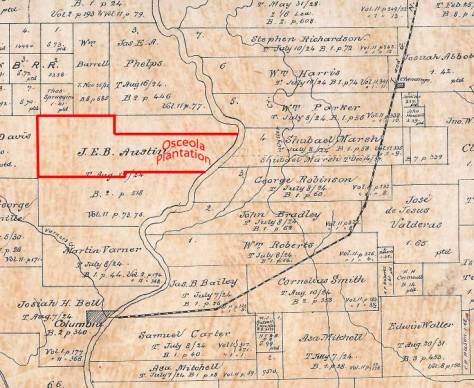
Osceola Plantation
Brazosport Archaeological Society
After the death of his wife Eliza Martha Westall Hill, William Green Hill developed the Osceola Plantation from the James E. B. Austin 3 League tract on the west side of the Brazos above the town of Columbia 1849-1850. This property had been inherited by his wife Eliza M. Hill from the estate of her first husband, J. E.B. Austin, brother of Stephen F. Austin. After the death of her second husband Zeno Phillips in 1835, Eliza married William G. Hill in 1836. Before Eliza’s death in 1847 William and Eliza Hill had been raising their family and her son by James E. B. Austin and her daughter by Zeno Phillips on the east side of the San Bernard River at Waverly Plantation (named by William G. Hill) the property of her deceased second husband.

Map 1879 Texas General Land Office
William G. Hill and his six children by Eliza Hill made their home at Osceola developing it into a cotton plantation until his death in 1860. After the Civil War Paul N. Spofford of New York gained control of the plantation and built a large sugar mill in the early 1870’s. Leasing the property to John Wells in the late 1870’s convict labor was potentially available to harvest the cane and corn crops at Osceola. With banking and shipping lines at their disposal Paul N. Spofford and Thomas Tileston were the owners of one of the largest investment and mercantile houses on the east coast, Spofford Tileston & Company of New York. During this same time period they purchased the Waldeck Plantation just south of Osceola. Paul N. Spofford chose to finance his holdings in Osceola on the east coast through the Sewell Estate. In 1880 the estate took over the Osceola Plantation and for the year 1882 John Wells again leased the property. In 1889 Branch T. Masterson bought the property at auction. Harris Masterson, T. L. Smith, John G. Smith, and Branch T. Masterson gained control of the large plantation in the early 1890’s. T. L. Smith started to divide part of the plantation up into small tracts and sell them to a group of Italian immigrants in 1893. The Italians seemed to have little knowledge of cane or cotton production and were gone from the area after only a couple of years. After trying rice farming for a couple of years, a scheme which didn’t prove profitable, in 1905 T. L. Smith bought out his partners. Cattle ranching became the main use of the property and the plantation remained with heirs of the Smith family until 2007.
Elizabeth Martha Westall (1807-1847) was the daughter of Thomas and ??? who lived at the Westall Plantation on the west side of the lower Brazos River. James Elijah Brown Austin (1803-1829), the brother of Stephen F. Austin, married Eliza M. Hill March 20, 1828 at San Felipe de Austin. Noah Smithwick added that Brown Austin was anxious to show due respect for the Mexican law and had notified Padre Muldoon but the padre failed to arrive on time. “The bride was ready and so was the feast, but everything had to await the pleasure and convenience of the dilatory priest.” Stephen F. Austin wrote to James F. Perry, “You are doubtless ere this informed by Brothers letters of the important change that has take place in his situation. He was married on the 20 of this month at this place to Miss Eliza Westall—he has made a good choice and I think has secured his domestic happiness—we are trying to arrange matters to set him and John Austin up in the Mercantile business…” A few months later Brown wrote to Stephen, “As to our future plans I have concluded to remain here for the present year, and am now employed putting the Gin in good order for the present crop…I am going to make a crop this season and if the Negroes hire low we should hire them…” The location of Brown’s gin is not exactly clear. He may have been working on his 3 league tract on the west side of the Brazos above Columbia. A portion of this property is often referred to as the ”Gin Tract” or on the out skirts what was to become Brazoria. He was required by Mexican law to show improvement on his property. Stephen F. Austin wrote a short time later to his sister Emily Perry, “You ask me how I like my sister in law—I am very well pleased with her, and think Brown has made a happy choice—they live very happily together and have the prospect of an heir this winter or early in the spring…” February 1829 their only child Stephen Fuller Austin II (1829-1837) was born. James E. B. Austin went into partnership with John Austin in a mercantile business fifteen miles upstream on the west side of the Brazos River. Stephen F. Austin gave the name “Brassoria” to this location. The partnership was expanded to include a mercantile store in Brazoria. John Austin and Brown made their home in Brazoria. Brown’s home and possibly the gin with out buildings were on the out skirts of town.
The next year Stephen F. Austin wrote to Emily again, “I am now at brothers who has settled at this place probably for life or at least for a few years—he is quite in the woods as yet, tho comfortable, and has a fine Boy as ever I saw—this place is 20 miles by water from the Mouth of the river and about 10 miles from the coast in a direct line. I think it will become a place of business.” Brown wrote to Emily Perry about the coming year just before sailing to New Orleans, “Crops look fine and we have every prospect of an abundant harvest, about 500 Bales of Cotton was made last year for exportation and about sixty or 80 hogsheads of Sugar. This year the Sugar crop will treble and a much larger Cotton crop than ever before.” Having left his family July 3, 1829 on a business trip to New Orleans James E. B. Austin died there August 14, 1829 of yellow fever.
Died of yellow fever in New Orleans on Friday the 14th
of August, after 63 hours of sickness in the 26th year of age, MR.
JAMES E. B. AUSTIN, a native of Potosi, Washington County, Missouri, and for
the last eight years, a resident of Texas. He visited New Orleans on business,
had been there but a few days, and was to have left the day he was taken sick.
H. D. Thompson wrote to Stephen F. Austin from New Orleans after Brown Austin’s death stating Brown had met with Thompson and Captain Harris at about 6 a.m. on an excessively hot day, and had made arrangements to meet Thompson again at his home that evening. Brown had complained of “being a little unwell” but did not appear in any way seriously ill. At 1 p.m., however, he complained of a pain at the pit of his stomach and a slight pain in the head. A physician was called, but by 3 a.m. the following day, Brown Austin was dead. He was interred at 5p.m. the same day “and had a deasent funeral”.
The first of the next year, Eliza M. Austin wrote to Emily M. Perry, “…I scarcely know what to say. You must long before this heard of the death of your dear Brother. You my dear Sister can well imagine what my feelings are; looseing all that was Dear to me in this world, my Husband, my friend, my protector, my all. But my Sister there is no remedy for the decrees of providence, but submission. Brother Stephen was at the same time very sick and not expected to live. We all thought that every moment was his last but God was merciful to us, and spared him to take care of his dear little Stephen…As I think it is not prudent for me to keep house alone in this new country, I intend to have me a room put up joining Capt. Austins. He has always been to me a brother and his wife a sister. We have lived together so long that I cannot think of leaving them…Little Stephen has been very sick with a singular breaking out. I at first thought it was the hives. He is now getting much better and thank you very much for his cap and beeds. He could walk a few steps before he was taken sick. He is now beginning to talk…”
Shortly after the death of her first husband Eliza M. Austin was courted by Zeno Phillips. Zeno Phillips was one of Stephen F. Ausitn’s Old Three Hundred colonists. He had received a league of land west of Columbia on the San Bernard River in 1824 and bought a portion of Samuel May William’s league on the opposite side of the river. The census of March 1826 classified him as a farmer and stock raiser, a single man aged between twenty five and forty, with one servant and twenty-two slaves. In 1829 he was in partnership with John R. Harris in one of the first contracts for cotton in Texas, when they bought about 100 bales from Jared E. Groce. Though there may have been several years’ difference in their ages, Zeno and Eliza were wed by May 1830 according to some court documents. They were already together when Moses Austin Bryan son of Emily M. Perry visited his aunt in January 1830:
…went to my
Aunts about five miles from Mr. Bells they were extremely glad to see me and I
am very much pleased with her & Col Phillips. I stayed their 10 days and
then I came hear and stayed with Mr. Williams 7 or 8 days…I dident have pleasure
of seeing my Uncle nor my little cousin my uncle started 3 weeks before we got
hear and my cousin was down at Mr Westales my Aunt wanted me to wait & she
would go down and fetch him up but I was very anxious to get up hear that I
could not wait…
While Moses A. Bryan expressed he was “very much pleased” with Eliza and Zeno Phillips being together this did not sit well with the rest of the family; perhaps the mourning period was a bit short. Before the end of the year Eliza Phillips was in communication with Stephen F. Austin who was the executor of James E. B. Austin’s estate and another side of Eliza’s personality started to emerge:
…writing
now and I am anxious to know how the business is or will be settled. You told
me last spring you would send me down a pertition to sign—for one league of
land—on Galviston. I want to know if the pertition was answered—or whether you
are authorized to grant it. I also wish to know what right John (Austin) had to
Lease out my hous and 10-acres for five years. that I always considered my
property. and it is hard to give it up. I loaned John last spring My watch on a
business day. he has not returned it. that I wish to reserve myself for
Stephen his father bought it for him and
gave it to me to keep it. the house John knows the circumstance very well…
Stephen F. Austin was hearing the other side of the story from his close personal friend John Austin at nearly the same time:
…I do not Comprehend the whole affair if I have taken a liberty with the place to
rent it etc. I thot. it yours and done what I believed to be of your interest,
I never have received one cent of the
rent Eliza has received it all, I have paid for some repairs making a chimney,
etc, If she has complained of me I wish to know it, I never had any other
feeling for her than I ought to have had for a sister. My conduct towards her
will prove it in me she found a friend
and protector if she complains of a liberty that I have taken with anything she
conceived her property I am astonished for She has taken as many liberties with
my things as my wife and has always been welcome…
The property under contention was later appraised “House and out buildings at the Prairie-$225.00” and “The gin house and cotton gin, as it stands-$140.00”. The only other description was given by John Austin, “The buildings are good the Gin house is sound with the exception of some of the posts on which it stands not much work to replace them…” There were several local residents interested in leasing the property but Jesse Thompson gave them the best offer to rent the Gin Place and may have won the deal.
Eliza and Zeno Phillips would have a daughter Sarah Olivia Phillips ( ?-1841). In order to receive an education Stephen F. Austin II would stay at Peach Point the plantation home of Emily Perry, Stephen F. Austin’s sister. Eliza paid tuition of $2.00 per month for seven months in 1834 to Thomas J. Pilgrim, who had several students from the area. Stephen F. Austin wrote to James Perry expressing “I wish to spare no pains or care in having little Stephen…well educated,” and “There will be enough out my property to educate him and Guy in the best manner possible. I wish them to have a finished education and to study law so as to take care of future interests of the family.
James F. Perry wrote to Stephen F. Austin on the progress of his namesake’s schooling and an ominous bit of information on the health of Zeno Phillips:
…Mr. Pilgrim continues with us the children are very well. Stephen F. Austin is going to school to him and begins to learn fast. Col. Philips is in a very bad health it is doubtful whether he will recover…
A year later, May 22, 1835 Zeno Phillips died and may have been at the beach for the healthful sea breezes before his death. Emily Perry wrote to her husband James F. Perry from Peach Point:
…I hear that the Scarlet Fever is above Mrs Phelps is
very ill with it, not expected to live, it is very ketching, & Dr. Jones
informed me, with grown Persons generally Fatal; do not go where it is
for God Sake; I shall not see one moments comfort until I see you; Col Phillips
is Dead, & the Family have all left the Mouth- I expect you will be
Solisted to settle his estate; I hope you will have nothing to do with it…
Emily Perry should not have worried that her husband would have to settle Zeno Phillips’ estate. William Green Hill (1801-1860) would become administrator of the estate and more. In 1825 William G. Green had married Mary Catherine Hall in Madison County, Alabama. They moved to Nashville, Tennessee where their two children were born. Shortly after the birth of their son Thomas Elihu Hill on May 23, 1829, Mary Catherine died. Thomas E. Hill would be raised by his grandparents in Tennessee until he was 16 or 17 when he joined his father in Texas. William G. Hill entered Texas in 1830.
In 1835 he entered the Texas army as a private in Fannin’s Brazos Guards. He fought at the battle of Concepcion on October 28, the Grass Fight on November 26 and the siege of Bexar on December 5-10. By January 1936 he had moved to the rank of captain of cavalry. February 25, 1836 he took leave of his military duties and entered into a $10,000 bond marriage with Eliza M. Phillips, widow of Zeno Phillips. Another less than customary time of mourning led to more whispers among the community and to another family which would later be cause for concern to the Hill family as Zeno Phillips had several brothers and sisters in Texas. Instead of returning to the army William G. Hill took steps to take care of his new family and property during Santa Anna advance across Texas. William Fairfax Gray encountered him at Ballow’s Ferry on the Sabine River:
At the ferry we found Colonel Wm. G. Hill, late of the San Bernard, who had been to take his family and that of E. Waller to the United States. He is now on his return. Waller, whom I saw at Beaumont, has charge of the negroes belonging to himself and Hill. They are trying to take them up Red River. Hill’s address will be Alexandria, La.
From June to October 1836 Hill served in Capt. Washington H. Secrest’s company of Columbia Cavalry.
Zeno Phillips’s estate:
1 Negro Man named Eoline
$1000
1 Do Do Do
Lewis 1000
1 Do Do Do
Abram 1000
1 Do Woman
Do Lucy 700
1 Do Do
Do Lila 600
1 Do Boy Do
Lew 1000
1 Do Girl Do
Adeline 120
1 Do Child Do
Hastings 200
1 League of land on the Brazos
& Navasota 2214
This inventory completed in 1837
does not include the Zeno Phillips League and the portion of the Samuel M.
Williams League which he had purchased. This is also a substantial less number
of slaves than he had in 1826.
In December 1836 Stephen F. Austin would die of pneumonia at Columbia and in February 1837 Stephen F. Austin II would also. Many in the county had felt that through Eliza’s neglect her son by J. E. B. Austin had died and she was not entitled to his and her first husband’s estate but the courts would decide otherwise. A lawsuit was filed in the Brazoria District Court in 1838 by the Perrys against Eliza M. Hill and later taken all the way to the Republic of Texas Supreme Court where it was settled in 1842. The question at issue came from the construction of a single clause in the olographic will executed by Stephen F. Austin April 19, 1833 before seven witnesses, which is as follows:
“That all the residue of my property shall be divided into two equal portions, as nearly as may be, and I give unto my sister Emily F. Austin, wife of James F. Perry, one of said portions, and the other portion I give and bequeath to my nephew Stephen F. Austin, son of my brother James E. B. Austin, and Eliza Martha Westall his wife. In case my said nephew should die without legal issue, then the bequest to him shall pass to, and be inherited by my sister Emily, and her heirs, and no other person whatsoever.”
Whereas most of us who read this clause in Stephen F. Austin’s will feel we know that Austin wanted all his property to go to his sister Emily Perry if his nephew did not live and have any children; we are not students of Spanish law. William G. Hill was a lawyer and understood the necessity of getting a good lawyer to present their case. It is not clear who made the final presentation for the plaintiffs but Patrick C. Jack made the plea for the defendants James F. Perry & Wife. His presentation may not have been on the highest level. The elaborate argument prepared by the plaintiffs makes the plea that the additional provision made by Austin which directed the bequest to the sister, if the nephew died without issue, was contrary to the Civil Law and also the Constitution of Texas. This clause is a disposition of the kind known in the civil law as a fideicommissry substitutuion. All fideicommissry substitutuions are a branch of, and included under the general name of fideicommissa. All fideicommissa were strictly prohibited by the express legislation of both Spain and Mexico at the time the will was written. The case was therefore governed by the Civil Law, as the English common law did not replace the Civil Law in Texas until January 20, 1840. The Texas Supreme Court ruled for the plaintiffs. Eliza M. Hill became the instant owner of many thousands of acres in several different Texas counties. The entire Bryan and Perry families would continue to harbor considerable bitterness toward the Hills for many years.
William G. Hill named Zeno Phillips’ homestead on the east bank of the San Bernard Waverly. At this home Eliza and William began their family. Six children would be born to them while they lived there. Andrew McCormick whose father had a neighboring plantation described Eliza Hill:
…She was a widow the time when she married Colonel Hill…but was still young and very attractive. She had been educated in the best schools in “The States,” was handsome and highly intellectual. She received from her first husband a large estate. Colonel Hill and his family lived sumptuously at their Bernard home, which was everywhere known as “Waverly,” which he had given it. He loved company, and organized his home with the view of indulging his taste in that direction and so that he might entertain much company well and easily. After he had been living at Waverly a number of years, he and his family were one day visitors at Madam Bell’s, when she casually made allusion to some of the inconveniences of living on the public road. “Think Madam,” he said “what it must be at the end of the public road.”
In September 1841 Sarah Olivia Phillips died and was buried at Waverly near her father Zeno Phillips and his brother John Clark Phillips. In 1842 the Zeno Phillips estate is listed on the tax rolls as having 7 slaves and 13,084 acres of land. William G. Hill’s own property is listed as 27 slaves and 36,681 acres of land plus many lots in various towns, a great portion of which was Eliza’s inheritance. The surveying and division of property with the Perrys would take several years. William G. Hill wrote many times to James F. Perry during the early 1840’s concerning the surveying that was progressing much too slowly for him and Eliza. All of these were addressed “On Bernard” or “Waverly” indicating the family was still living at Waverly.
William and Eliza’s last child, Charles Norfleet Hill, was born in 1846 and Eliza died in June or July 1847. All her property was placed in her estate with William G. Hill as executor. Immediately after her death James R. Phillips applied as executor but was not allowed as he was part of a law suit against Eliza and William G. Hill. Since Zeno Phillips had died intestate and Sarah Olivia Phillips was a minor the Phillips family was claiming a portion of the slaves and land owned by Zeno Phillips before his marriage. This case was taken to the Texas Supreme Court but was sent back for further litigation. Additional litigation ended with the Phillips family receiving ownership of much of Zeno Phillip’s land including the Waverly Plantation. In 1848 William G. Hill is listed in the tax record as still the administrator of Zeno Phillips’ estate and by 1850 James R. and Sidney Phillips are listed as the property owners.
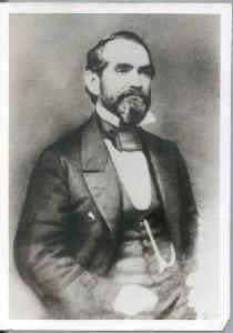
William G. Hill Sr. Unknown Date
By 1850 William G. Hill had moved his family to Osceola Plantation. This 6500 acre cotton plantation was on the west bank of the Brazos River above Columbia in the James E. B. Austin 3 League tract which had been inherited by Eliza Hill. The 1850 Census lists the Hill family with only his daughter Ann E. missing probably at school:
William
G. Hill 49 M North Carolina
Wm.
G. Jr. 4 M ? Texas
(Should be 11 or 12 years old)
James
W. 9 M Texas
A
Eenas (A. E. Phelps) 7 M Texas
John
B.
5 M Texas
Charles
N. 3 M Texas
B.
C. Jeffries (Bricklayer) 24 M Virginia
The 1850 Agricultural Census lists William G. Hill with 275 acres under cultivation. The tax rolls list 47 slaves, 28 head of horses, and 400 head of cattle in his possession. As administrator of the Eliza M. Hill estate he had applied for at least $1500 per year from the estate to support the children. As money or liens became due Hill would sell or auction off a tract of land to supplement the income of the cotton sold each year.
1847
Cotton Crop
16 Dec 9 Bales $201.97
30 Dec 12 Bales $290.07
17 Feb 6 Bales $174.24
13 March 22 Bales $646.21
11 March 10 Bales $300.81
Total 59 Bales $1613.30
1848
Cotton Crop
15 Dec 10 Bales $222.16
2 March 7 Bales $151.20
20
Feb 8 Bales $201.18
Total
25 Bales $574.54
1849
Cotton Crop
14 Nov 5 Bales $231.88
14 Nov 20 Bales $985.15
14 Nov 5 Bales $223.17
April 30 Bales $1154.80
27 April 21 Bales $862.24
1 July 30 Bales $1282.34
1 July
8 Bales $334.12
1 July 5 Bales $214.81
Total 114 Bales $4248.33
1850
Cotton Crop
76
Bales $2216.08
1851
Cotton Crop
105
Bales $3351.66
1852
Cotton Crop
86
Bales $3528.45-15 Bales
unsold to be sold later
10
Bales $399.36
1855
Cotton Crop 131 Bales $6690.21
1856
Cotton Crop 67 Bales $4712.99
1857
Cotton Crop 85 Bales $4490.03
1858
Cotton Crop 141 Bales $7284.97
1859
Cotton Crop 165 Bales $8319.40 (1858 & part of 1859
crops together not sure break point)
It appears that possibly after 1848 that cotton was produced on a larger scale which might indicate the move to the Osceola plantation with 1848 being the first year to break ground. The pattern of life at Osceola seems fairly consistent until October 1, 1857 when William G. Hill’s daughter Ann E. Hill married Dr. Robert H. Boxley.
The 1860 Census lists the William G. Hill household:
William G. Hill, Sr. (Planter) 59 M North Carolina
Wm. G. Jr. 21 M Texas
James W. 19 M Texas
Phelps E. 17 M Texas
John B. 15 M Texas
C. Norfleet 13 M Texas
Joseph F. Goode 5/12 M Alabama
H.M. Rhodes (Overseer) 27 M Georgia
P. V. Sisson (Teacher) 23 M New York
J. V. Mason 52 M District Columbia
William G. Hill’s son by his first marriage had also moved to Brazoria County and by the ages of his children he had been in Texas for several years:
Thomas E. Hill (Lawyer) 31 M Tennessee
Frances A. 25 F Louisiana
William B. 3 M Texas
Hellen 1 F Texas
Tax records list 66 slaves, 26 head of horses, and 300 head of cattle in William G. Hill’s possession. The 1860 slave census records 66 slaves and 15 slave dwellings. Evidently at this time William G. Hill may have been in bad health. His immediate business was the partition of his personal property from the estate of his wife Eliza M. Hill. In May of 1860 twenty four slaves (men, women, and children) were valued at $21950. These slaves were then divided into two lots of fairly equal value. The lots were drawn with one lot for the Estate of Eliza M. Hill and the other for William G. Hill. The estate of Eliza M. Hill then had a total of 47 slaves valued at $42,600. Six lots were then made and drawn by each of the children. Eliza M. Hill’s estate had vast land holdings stretching from Brazoria into Austin, Matagorda, Wharton, Fort Bend, Brazos, Bexar, Denton, and Burleson counties. Each child received an estimated value of ~$17,000 in slaves and property from the estate.
The urgency of getting the inventories and partitions completed became apparent as on June 30, 1860 William G. Hill gave his nuncupative will on his death bed: “To his son Thomas E. Hill his land received from Carson, Negroes Liam, Lily & Ephaim and all the rest of his property to be equally divided between all his dear children…Request that he should be buried with his wife or by her side and one slab over them both with his name on one side and his wifes on the other… June 30th 1860”
William G. Hill’s estate totaled $25,562.03 including 24 slaves, 1000 head of cattle, and less than 2000 acres of land. The slaves were again partitioned into seven lots with each child drawing their lot.
Thomas E. Hill and Dr. Robert H. Boxley, husband of Ann E. Hill, were appointed guardians and administrators of the estate. As there were several minor children Dr. Boxley paid their expenses from the Eliza M. Hill estate and credited every one with a 1/6 share from the sale of the cotton crop. The plantation itself was rented from the estate for $2000/year by the heirs. At the start of the Civil War the plantation produced a good crop of cotton in 1861 which sold for $6356.40. Expenses for 1861 and 1862 list transportation costs to and from Chappell Hill where John B. and C. Norfleet Hill may have been attending school for this time period. According to Abner Strobel some the boys were in the Confederate Army and made distinguished records. Charles Norfleet Hill served in Company F 35th Texas Calvary.
Their 1862 crop of 103 bales of cotton sold for $9375.30 and they made an additional $862.50 on 690 bushels of corn. In 1863-1864 the effects of the war could be seen on the price of cotton and corn. Osceola produced half the crop in bales of cotton as to the previous year but twice the amount of money. Money that was rapidly decreasing in value:
Oct
19, 1863 6 Bales $1825.00 $304.17/Bale Dr.
Perkins
Jan
13, 1864 20 $5439.42 $271.97 S.
A Styles Confederate States
Jan
21 12 $3158.00 $263.17
R.
& D.G. Mills
Mar
1 12 $4359.00 $363.25
R.
& D.G. Mills
April
1 7 $5910.00 $844.29
John
Adriance
Total 57 Bales $20591.42
Nov
19, 1863 171 Bushels $514.30 J. Kennedy
Dec
12 42 $106.20
A. Sessums
Dec
15 27 $80.00
J.
W. Lawrence
Dec
29 508 $698.50 Capt. Ransom
Totals for 1864-1865 are incomplete. A. E. Phelps Hill may have been in bad health and he sold his slaves and his share of the plantation to Dr. Robert H. Boxley and his wife in 1864. The plantation then ran on 1/5 shares with the rest of the children. Phelps Hill died in 1867. William G. Hill Jr. and his family continued to run the plantation for the next several years. In November 1869 William G. Hill Jr. died and willed his property and interest in the plantation to his two sons William G. Hill III and James W. Hill with no mention of a wife alive at this time. His estate only lists a ¼ portion of 200 acres being the homestead on Osceola Plantation.
February 1870 the Osceola Plantation less the 200 acre homestead was sold at auction to John Adriance, a local merchant from East Columbia, for $10050. Shortly thereafter he purchased the homestead. The estate auctioned the property due to debt owed Adriance in the running of the plantation for several years. John Adriance sold the Osceola Plantation the same month for $20,000 to Paul N. Spofford of New York. He built a large sugar mill near the Brazos River ~1870-1873. J. H. Colson, a carpenter, worked on the mill October 25, 1872–June 16, 1873 with $440 owed for his services. Although Paul N. Spofford was part owner with Thomas Tileston in Spofford Tileston & Company of New York, one of the largest investment and mercantile houses on the east coast which had banking and shipping lines at its disposal, he financed Osceola through private mortgages in 1874 and 1875. For operating expenses for 1875 and 1876 he used Spofford Bros. & Co. to which consigned the annual crop. When additional financing was needed he turned to Clinton C. Baker and Louis H. Rowan trustees for the Thomas Sewell estate. His company purchased the Waldeck Plantation, a large sugar and cotton plantation, just to the south of Osceola during this same time period. Leasing the property to John Wells in the late 1870’s convict labor (38 Convicts) was potentially available for the cultivation and harvest of the cane and corn crops at Osceola. For operating capital he consigned the corn and cotton crop to S. H. Kimball. In 1880 the Sewell estate purchased the Osceola Plantation at a foreclosure sale on Paul N. Spofford. Their first year “the crop of cane sugar, molasses, corn, and other products.” was consigned to Mark Marx & Harris Kempner of Galveston and they mortgaged “mules, wagons, kettles, coolers” to secure the note for money and supplies to run the plantation. For the year 1882 John Wells again leased the property and he continued to have access to convict labor. The 41 convicts listed may have been used on Waldeck and Osceola Plantation as he leased both properties.
Several less than honest foreclosure deals took place in 1888. Clinton C. Baker and his wife Frances Isabella Sewell Baker brought suit against Harris Masterson et al and the suit was settled in the Galveston Federal Court in the Bakers’ favor. In 1889 at an auction by the US Marshal Branch T. Masterson bought Osceola for $12000 with all of that amount going to Clinton and Frances Isabella Baker.
Harris Masterson, T. L. Smith, John G. Smith, and Branch T. Masterson gained control of the large plantation in the early 1890’s. John G. Smith had arrived in Brazoria County in the late 1860’s with his brother Travis L. Smith arriving a couple years later in 1871. They ran a mercantile business, J. G. Smith & Bros., in East Columbia and had seven steam boats running on the Brazos River of which the Alice Blair and Hiawatha were top of the line.
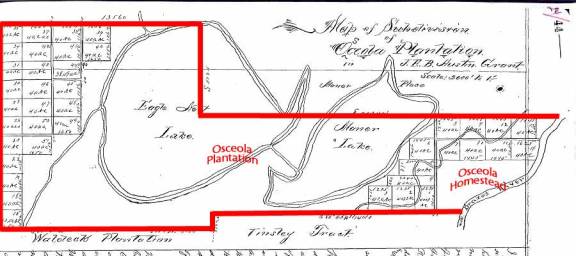
T. L. Smith started to divide part of the plantation up into 40 acre tracts and sell them to a group of Italian immigrants in 1893. The Italians seemed to have little knowledge of cane or cotton production and in their first year planted onions. Since there was not a large market for onions, Travis built a galvanized-iron warehouse and stored them. The roof of the warehouse leaked spoiling the onions which to be pushed down a chute into the Brazos River. At the same time that the majority of the Italians were planting onions, a few planted cotton. However, the Italians sold the Paris Green mixture which was given them to dust the cotton to kill pests to neighboring farmers instead of using it on the cotton. They were gone from the area after only a couple of years. T. L. Smith tried rice production for a couple of years but this scheme didn’t prove profitable either. The 1900 hurricane partially destroyed his first crop and the next year the lakes on the northern part of the property which he used for irrigation went dry. In 1905 T. L. Smith bought out his two partners for $5000 each. In 1909 he added the Manor Plantation just north of Osceola to his holdings. Cattle ranching became the main use of the property and the plantation remained with heirs of the Smith family until 2006 when it was sold to the Spanish Trail & Cattle Co.
While no excavations or survey work have been done in the area of the residence, slave quarters, or cotton gin area at Osceola, in 1996 limited excavations to identify the structural components were conducted by Joan Few at the sugar mill. The sugar mill since it was built 20-25 years later than most of the mills in Brazoria County had many of the structural components still intact.
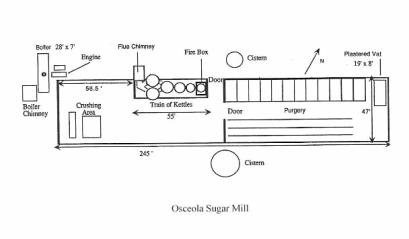
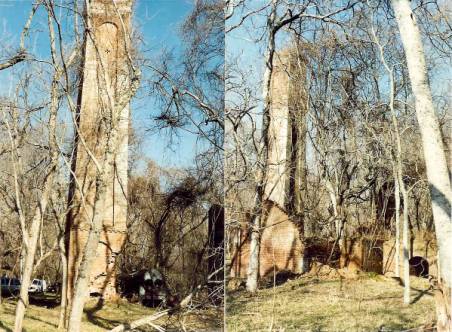
Photos January 1996 Osceola Boiler Chimney ~45’ Height (Courtesy W. Sue Gross)
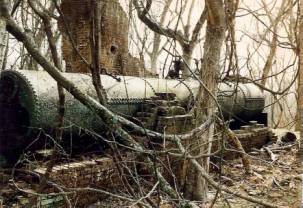 Photos January 1996 Osceola Boiler 28’ Length
(Courtesy of W. Sue Gross)
Photos January 1996 Osceola Boiler 28’ Length
(Courtesy of W. Sue Gross)
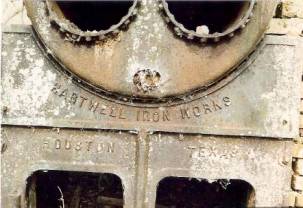
Osceola Fire Box (Courtesy W. Sue Gross
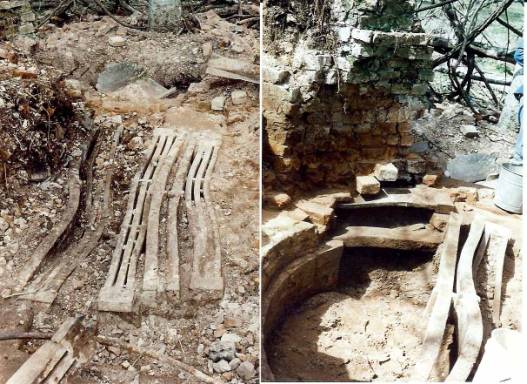
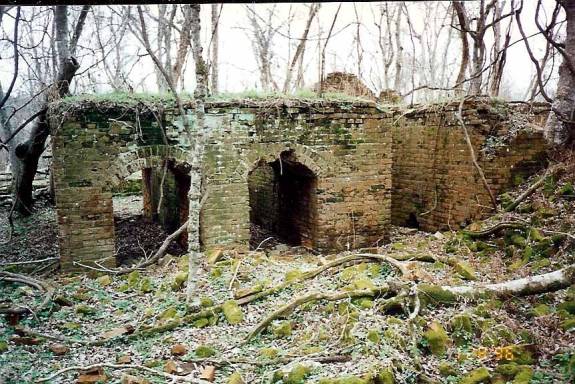
Photo January1996 Osceola Crusher and Engine Foundations (Courtesy W. Sue Gross)
Photos January 1996
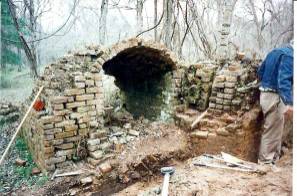
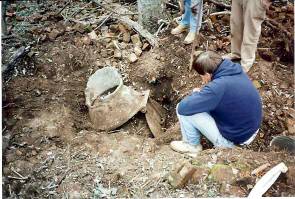
Photos January 1996
Excavations (Courtesy of W. Sue Gross)
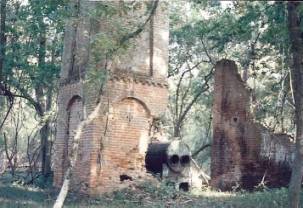
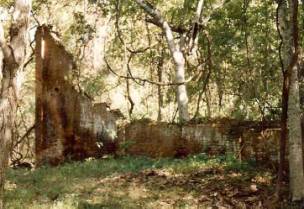
Photos 1996 Osceola
(Courtesy of W. Sue Gross)
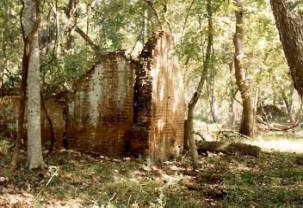
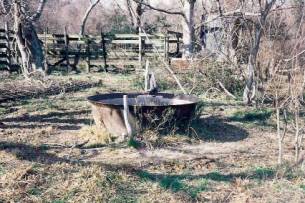
Photos 1996 Osceola
(Courtesy of W. Sue Gross)
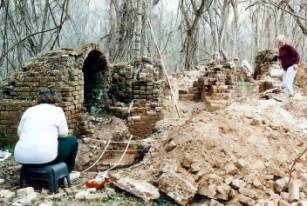
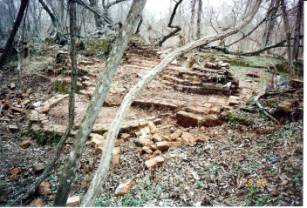
Photos Excavations
1996 Osceola (Courtesy of W. Sue Gross)
Appendix A
Genealogy
Elizabeth Martha Westall b.
1807 Potosi County, Missouri? Tennessee? Virginia? (Thomas Westall & ???)
d. June or July 1847
Waverly Plantation, Brazoria County, Texas
married 1st March 20, 1828 San Felipe de Austin, Texas
James Elijah Brown Austin b.
October 3, 1803 Potosi County, Missouri
d. August 17, 1829 New Orleans, Louisiana
1. Stephen Fuller Austin II b. February 1829 Brazoria
County, Texas
d. February 1837 Waverly Plantation, Brazoria
County, Texas
married 2nd May 1831 Brazoria County, Texas
Zeno Phillips b. ?
d. May
22, 1835 (Quintana ?, Brazoria County, Texas)
1. Sarah Olivia Phillips b. Waverly Plantation
d. Sept. 10,
1841 Waverly Plantation, Brazoria County, Texas
married 3rd February 25,
1836 Brazoria County, Texas(his 2nd marriage)
William Green Hill b. 1802
Franklin Co., North Carolina (Jordan Hill and Mary Nancy Green)
d. June 30, 1860 Osceola Plantation, Brazoria County, Texas
1. William G. Hill Jr. b. 1838 Waverly Plantation,
Brazoria County, Texas
d. November 10, 1869 Osceola Plantation,
Brazoria County, Texas
married September 27, 1861
Elizabeth C. Burney b.
2. Ann E. Hill b. 1839 Waverly Plantation, Brazoria County, Texas
married October 1, 1857 Brazoria County
Dr. Robert
H. Boxley b. 1831 Virginia
d.
January 17, 1896 Hempstead, Texas
3. James W. Hill b. 1840 Waverly Plantation, Brazoria
County, Texas
d. ?
4. Aneas E. Phelps Hill b. 1842 Waverly Plantation,
Brazoria County, Texas
d. 1867
5. John B. Hill b. August 4, 1845 Waverly Plantation,
Brazoria County, Texas
d. October 31, 1899 Houston,
Harris County, Texas
married February 19, 1867 Fort Bend
County, Texas
M. Louisa Tomlinson b. 1848
d. ~1877 Fort
Bend County, Texas
6. Charles Norfleet Hill b. June 1846 Waverly
Plantation, Brazoria County, Texas
d. August 10, 1902 Sandy Point, Brazoria County, Texas
married March 5,1873
Q. B. Cash b. 1856 Sandy Point, Brazoria County,
Texas
d. November 29, 1933 Corpus Christi, Texas
A. John Harvey Hill (1874-before
1933) B. E. (Luana) H. Hill (1876-?)
C. Rose P. Hill (June 18,
1879-?) D. Charles Norfleet Hill Jr.
(1887-1933)
E. William G. Hill (1890-before
1942)
Appendix B
Eliza M. Hill Estate Personal Property 1848
Negroes Digga Man aged about 50 years Value $200.00
Dick 26 700.00
Washington 30 600.00
George 30 600.00
Joshua 28 650.00
Lawrence 28 650.00
Ben 26 700.00
Daniel 26 700.00
French 32 600.00
Jim 30 700.00
Henry a boy 14 600.00
Willis 8 300.00
Abram 7 300.00
George 4 250.00
Tom 4 250.00
Charles 3 200.00
Green 1 100.00
Aley a Woman aged 35 years 500.00
Kitty 40 300.00
Chancy 55 100.00
Mary 26 450.00
Rose 26 450.00
Betsy 26 450.00
Susan 18 500.00
Lotty a girl 14 400.00
Mary Ann 10 350.00
Cindarilla 10 350.00
Frances 8 250.00
Phillis 8 250.00
Celia 5 225.00
Priscilla 3 200.00
Clarinda 2 100.00
Nancy 1 100.00
300 Head of horned cattle valued @ 3 ½ each 1050.00
Furniture
One Side Board value at 75.00
One Mahogony Armour 175.00
Two Bureaus 30.00
One Doz Mahogony chairs 40.00
One Pr. Lard tubs 10.00
One Mahogony Bed Stead 50.00
Three Cherry Bed Steads 30.00
One Mahogony wash stand 5.00
One Mahogony Rocking chair 2.00
One Pr. Dining Tables 5.00
Three Hair Matresses 40.00
One Feather Bed 20.00
Four Pr. Bed blankets 20.00
Four Pr. Sheets 15.00
Four Marseilles Bed Spread 16.00
Ten feather pillows 10.00
Four feather bolsters 12.00
Two Cut Glass Stands 10.00
Two Cut Glass dishes 6.00
Four Cut Glass Decanters 12.00
Eight Cut Glass Goblets 8.00
Two fruit dishes or baskets (china) 5.00
Two Claret Decanters 6.00
Two Stock Decanters 6.00
Eighteen Silver Table Spoons 100.00
Eighteen Silver Tea Spoons 50.00
Eighteen Silver Dining forks 100.00
Eighteen Silver Breakfast forks 50.00
Two Solar Lamps 5.00
One Astral Lamp 10.00
One Pr. Brass andirons 10.00
Four Brass Fenders 12.00
Three Prs. Shovel & Tongs 3.00
Real Estate
Appendix C
Deed Records
|
GRANTORS |
GRANTEES |
Kind of Instrument |
Book |
Page |
Month |
Day |
Year |
Acres |
Description |
|
Mexican Government |
James E.B. Austin |
Deed |
SR |
|
July |
10 |
1824 |
|
J.E.B.
Austin 3 League Tract |
|
Estate James E. B. Austin |
William G. & Eliza M. Hill |
|
|
|
|
|
|
|
|
|
Estate of Eliza M. Hill & Estate of Wm. G. Hill |
A. E. Phelps Hill |
Deed |
K |
437/38 |
March |
19 |
1864 |
|
1/6 Of
his mother’s estate & 1/7 of his father’s estate in slaves, livestock,
and lands |
|
A. E. Phelps Hill |
R. H. Boxley & William G. Hill Jr |
Deed |
K |
458/59 |
July |
27 |
1864 |
6500 |
$2500
Confederate Treasury Notes 1/6 Interest in Osceola |
|
A. E. Phelps Hill |
R. H. Boxley |
Deed |
K |
482 |
Nov |
5 |
1864 |
|
4 Slaves
$850 |
|
Robert H. Boxley Administrator Eliza M. Hill |
John Adriance |
Deed |
Q |
488/89 |
Feb |
7 |
1870 |
|
¼ of 200 acre homestead residence & improvements $750 |
|
Robert H. Boxley Administrator |
John Adriance |
Deed |
Q |
490/91 |
Feb |
5 |
1870 |
|
$10050
All of Osceola less homestead at auction |
|
Heirs of Estate & creditors |
Paul N. Spofford |
Release |
Q |
491/92 |
Feb |
25 |
1870 |
|
Release
their claims to Osceola homestead |
|
John Adriance |
Paul N. Spofford New York |
Deed |
M |
566/68 |
Feb |
17 |
1870 |
6500 |
Osceola
Place $20,000 |
|
Heirs of Estate |
John Adriance |
Release |
Q |
493/95 |
Jan |
24 |
1871 |
6500 |
Osceola
Plantation |
|
J. H. Colson |
Paul N. Spofford |
Mech. Lien |
N |
758 |
Aug |
4 |
1873 |
|
Carpenter
work on Sugar Mill 25 Oct 1872-16 June 1873
$440 |
|
Paul N. Spofford |
Daniel Dodd |
Mortgage |
O |
324/26 |
July |
13 |
1874 |
6500 |
$20000 note secured by Osceola Lands |
|
Paul N. Spofford |
Susan Spofford |
Mortgage |
O |
611/13 |
Feb |
11 |
1875 |
~6700 |
$25,000
note secured by Osceola lands |
|
Paul N. Spofford |
Spofford Bros. & Co. |
Deed |
O |
777/78 |
June |
29 |
1875 |
|
Consignment
of Crops from plantation to pay operating expenses |
|
Paul N. Spofford |
Jacob Cromwell |
Mortgage |
P |
366/68 |
Feb |
10 |
1876 |
6500 |
$10,000 |
|
Susan Spofford |
Jacob Cromwell |
Agree |
P |
368/69 |
Feb |
10 |
1876 |
|
Her lien
subordinate to his |
|
Paul N. Spofford |
Spofford Bros & Co. |
Deed |
P |
557 |
June |
12 |
1876 |
|
1876
crop consigned to Spofford Bros |
|
Daniel Dodd |
Mercantile Trust Company |
Release |
Q |
496 |
Oct |
4 |
1876 |
|
$16333.42
release his note |
|
Mercantile Trust Company |
Clinton C. Baker Louis H Rowan trustees |
Deed |
Q |
500/01 |
Oct |
18 |
1876 |
6500 |
Osceola
Plantation for Frances Isabel Sewell Baker |
|
John Adriance |
Paul N. Spofford |
Release |
Q |
497 |
Oct |
11 |
1877 |
6500 |
$20,000
note paid |
|
Jacob Cromwell |
Paul N. Spofford |
Agreement |
Q |
497/98 |
Oct |
15 |
1877 |
6500 |
Agreement
to allow Spofford to finance additional loan |
|
Susan Spofford |
Paul N. Spofford |
Agreement |
Q |
498/99 |
Oct |
15 |
1877 |
6500 |
Same |
|
Paul N. Spofford |
C. G. Baker Louis H. Rowan |
Mortgage |
Q |
500/01 |
Oct |
15 |
1877 |
6500 |
$27,500
for Isabella Baker now carries 3 mortgages |
|
|
|
|
|
|
|
|
|
|
|
|
|
|
|
|
|
|
|
|
|
|
|
Paul N. Spofford |
William P. Ballinger & D. Noble Rowan |
Deed Trust |
Q |
504/08 |
Oct |
15 |
1877 |
6500 |
$27500 |
|
Jacob Cromwell |
Clinton C. Baker Louis H Rowan trustees |
Deed |
Q |
501/02 |
Oct |
19 |
1877 |
|
$3000
3/10 of mortgage P 366/68 |
|
G. K. Garrison |
Clinton C. Baker Louis H Rowan trustees |
Deed |
Q |
674 |
Jan |
18 |
1878 |
|
Agrees
his mortgage subordinate to Baker & Rowan |
|
Paul N. Spoffard |
John Wells |
POA |
R |
172 |
July |
15 |
1878 |
|
Power to
mortgage crops on Osceola |
|
John Wells |
S. H. Kimball |
Deed |
R |
173 |
Aug |
20 |
1878 |
|
Consignment
of Corn & cotton crop for money to run plantation will receive commission |
|
Clinton G. Baker |
Ballinger & Rowan |
Request |
S |
430 |
Nov |
25 |
1879 |
|
Request
to foreclose on Paul N. Spofford |
|
Clinton G. Baker |
Linn A. Stewart |
Request |
S |
432 |
Jan |
16 |
1880 |
|
Request to foreclose on Paul N. Spofford |
|
Linn A. Stewart |
Clinton C. Baker Louis H Rowan trustees |
Deed |
S |
433/35 |
Feb |
15 |
1880 |
6500 |
$18000
All land, machinery, livestock foreclosure sale |
|
Clinton C. Baker Louis H Rowan trustees |
Thomas W. Moore |
Deed Trust |
S |
626 |
April |
22 |
1880 |
6500 |
$40500 |
|
Clinton C. Baker Louis H Rowan trustees |
Thomas W. Moore |
Deed |
S |
630/31 |
April |
22 |
1880 |
6500 |
$40500 |
|
Thomas W. Moore |
Frances Isabel Sewell Baker |
Deed |
S |
631/32 |
April |
22 |
1880 |
6500 |
Osceola
Plantation $40500 |
|
Clinton G. & Frances I. Baker |
Marks Marx & Kempner Galveston |
Mortgage |
T |
40/42 |
Feb |
24 |
1881 |
|
Consignment
1881 crop of cane sugar, molasses, corn etc. for money & supplies to run
plantation used mules, wagons, kettles, coolers to secure note |
|
Marx & Kempner |
C. G & Frances I Baker |
Release |
U |
41/42 |
Jan |
27 |
1882 |
6500 |
Release T40/42 |
|
Frances Isabella Baker |
John Wells |
Lease |
U |
85 |
Jan |
27 |
1882 |
6500 |
Lease
for 1 yr for $5 and payment of taxes for purpose of sugar plantation |
|
Sheriff Auction Galveston |
Harris Masterson |
Deed |
W |
136/38 |
March |
4 |
1884 |
6500 |
Marx
& Kempner suit against G.C & Frances I. Baker |
|
M. J. Hickey Shr. |
H. W. Chinn |
Deed |
1 |
31/32 |
Mar |
6 |
1888 |
|
$100
Auction Oseola |
|
H. W. Chinn |
H. Masterson |
Deed |
4 |
70 |
June |
15 |
1888 |
|
$35
Osceola |
|
Clinton C. Baker Louis H Rowan trustees |
Harris Masterson et al |
Decree |
4 |
70/74 |
Feb |
18 |
1889 |
6500 |
Court in
favor of Baker set sale date |
|
US Marshal Auction |
Branch T. Masterson |
Deed |
3 |
105/07 |
June |
5 |
1889 |
6500 |
$12000 Osceola Plantation suit against H.
Masterson et al. |
|
T.L.Smith |
Various Italian Families |
Deed |
21 |
523,25,46,48, 55,84, 86,87, 89 |
Aug |
4 |
1893 |
|
Various
40 acre tracts from Osceola not mill area $1500-$2000 each |
|
|
|
|
24 |
44 |
Aug |
5 |
1893 |
|
Plat |
|
B.T. Masterson , J. G. Smith, and H. Masterson |
T. L. Smith |
POA |
25 |
166 |
Oct |
16 |
1893 |
|
Authorize
T. L. Smith to sell tracts |
|
|
|
|
|
|
|
|
|
|
|
|
H. Masterson |
T. L. Smith |
Deed |
67 |
194/95 |
April |
1 |
1905 |
6500 |
$5000 +
any debts against the property 1/3 share |
|
B.T. Masterson |
T.L. Smith |
mortgage |
70 |
278/79 |
July |
14 |
1905 |
|
$5000 his 1/3 share |
|
B. T. Masterson |
T. L. Smith |
Release |
70 |
279 |
July |
15 |
1906 |
|
|
|
T.L.Smith |
Osceola Irrigation Co. |
Deed |
71 |
336 |
Aug |
1 |
1906 |
|
Osceola Irrigation Co. $49800 |
|
E. P. Keenan |
T. L. Smith |
Deed |
85 |
330 |
Mar |
27 |
1909 |
|
Manor
Plantation |
|
TL Smith Family |
Osceola Surface Partners |
Deed |
|
|
July |
10 |
2006 |
|
2006040535 |
|
Osceola Surface Partners |
Spanish Trail & Cattle Co |
Deed |
|
|
July |
24 |
2006 |
|
2006043465 |
|
|
|
|
|
|
|
|
|
|
|
BIBLIOGRAPHY
Primary Sources
UNPUBLISHED
PAPERS
Brazoria County Historical Museum Library, Angleton, Texas
James F. Perry and Stephen F. Perry Papers
Osceola Plantation File
Travis L. Smith Family File 20
McCormick, Andrew Phelps, “Scotch-Irish in Ireland and in America” Unpublished book distributed to relatives and friends of Andrew Phelps McCormick, 1897
Streeter Collection on Microfilm
Texas State Archives, Austin, Texas
Biennial Reports of the Directors and Superintendent
of the Texas State Penitentiary at Huntsville, Texas with The Report of the
Prison Physician, Commencing December 1, A.D. 1878, and terminating October 31,
A.D. 1880, News Book and Job Office,
Galveston, Texas, 1881
Biennial Reports of the Penitentiary Board and
Superintendent of the Texas State Penitentiary at Huntsville, Texas, with
Reports of Physician and Chaplain, November 1, 1880 to October 31, 1882, E. W. Swindells, State Printer, Austin, Texas, 1882
NEWSPAPERS AND PERIODICALS
Texas Gazette
GOVERNMENT
DOCUMENTS
Deed and Probate Records Brazoria County, County Clerk’s Office, Angleton, Texas
Brazoria County Tax Records on microfilm Brazoria County Historical Museum, Angleton, Texas
Federal Population Schedule, Seventh Census of the United States.
1850 The State of Texas, Brazoria County
“Schedule 2—Slave Inhabitants in the County of Brazoria, Texas”
Federal Population Schedule, Eighth Census of the United States.
1860 The State of Texas, Brazoria County
“Schedule 2—Slave Inhabitants in the County of Brazoria, Texas”
Federal Population Schedule, Ninth Census of the United States.
1870
Secondary Sources
BOOKS,
ESSAYS, THESES, AND DISSERTATIONS
Barker, Eugene C. ed., The Austin Papers, Vol. II, American
Historical Association, United States Government Printing Office, Washington D.
C., 1928
Creighton, James A., A Narrative History of Brazoria County, Texian Press, Waco, Texas, 1975
Few, Joan, Sugar, Planters, Slaves, and Convicts, Few
Publications, 700 Hill Street, Gold Hill, Colorado, 2006
Gray, William Fairfax, From Virginia to Texas, 1835 Diary of Col.
Wm. F. Gray, Fletcher Young Publishing Co., Houston, Texas, 1965
Jones, Mary Beth, Peach Point Plantation, Texian Press, Waco, Texas, 1982
Smith, Travis L. Jr., “Steamboats on the Brazos” & “Travis L. Smith”in A History of Brazoria County: The Old Plantations and Their Owners in Brazoria County, Texas: Steamboats on the Brazos, n.p., 1958
Smithwick, Noah, The Evolution of a State, Stec-Vaughn Company, Austin, Texas, 1968
Strobel, Abner J., The Old Plantations and Their Owners of Brazoria County Texas, Revised Edition, The Union National Bank, Houston, Texas, 1930
The Handbook of Texas Online
Barker, Eugene C. ed., Letter Stephen F. Austin to James F. Perry, March 31, 1828, San Felipe de Austin, The Austin Papers, Vol. II, American Historical Association, United States Government Printing Office, Washington D. C., 1928, pp. 28-29.
Handbook of Texas Online, s.v. "," http://www.tshaonline.org/handbook/online/articles/AA/fau8.html (accessed December 11, 2008).
Barker, Eugene C. ed., Letter Stephen F. Austin to Emily M. Perry, May 26, 1829, Brasoria, The Austin Papers, Vol. II, American Historical Association, United States Government Printing Office, Washington D. C., 1928, p. 217.
Jones, Marie Beth, Peach Point Plantation The First 150 Years, Texian Press, Waco, Texas, 1982, p.13.
Barker, Eugene C. ed., Letter Eliza M. Austin to Emily M. Perry, January 6, 1830, Brazoria, The Austin Papers, Vol. II, American Historical Association, United States Government Printing Office, Washington D. C., 1928, pp. 318-319.
Handbook of Texas Online, s.v. "," http://www.tshaonline.org/handbook/online/articles/PP/fph5.html (accessed December 11, 2008).
James F. Perry and Stephen S. Perry Papers, Letter Moses Austin Bryan to William Joel Bryan, San Felipe, February 5, 1830.
Barker, Eugene C. ed., Letter Stephen F. Austin to Thomas Barnett, July 6, 1830, Brazoria, The Austin Papers, Vol. II, American Historical Association, United States Government Printing Office, Washington D. C., 1928, pp. 442-443.
Jones, Mary Beth, Peach Point Plantation The First 150 Years, Texian Press, Waco, Texas, 1982, p. 71.
Barker, Eugene C. ed., Letter James F. Perry to Stephen F. Austin, May 13, 1834, San Felipe de Austin, The Austin Papers, Vol. II, American Historical Association, United States Government Printing Office, Washington D. C., 1928, pp. 1055-1056.
James F. Perry and Stephen S. Perry Papers, Letter Emily M. Perry to James F. Perry, Peach Point, May 26, 1835.
In 1833 is a letter of introduction from an old friend of Stephen F. Austin: “This letter will be handed you by my friend Col. William K. Hill of this place, he is on a visit to Texas for the purpose of making a permanent location for himself and family; You will find him a gentleman of intellingence, and every way worthy of your attention and friendship… he has been for several years clerk to the Senate of this State And discharged his duties with approved ability and skill…” Barker, Eugene C. ed., Letter Charles W. Webber to Stephen F. Austin, February 15, 1833, Columbia, Tennessee, The Austin Papers, Vol. II, American Historical Association, United States Government Printing Office, Washington D. C., 1928, pp. 928-929. Some family sources have his arrival as 1830. This may not be William G. Hill but he was known as Col. Hill before any service with the Texas army.
Handbook of Texas Online, s.v. "," http://www.tshaonline.org/handbook/online/articles/HH/fhi27.html (accessed December 11, 2008).
Gray, William Fairfax, From Virginia to Texas, 1835 Diary of Col. Wm. F. Gray, Fletcher Young Publishing Co., Houston, Texas, 1965, pp. 169-170.
Ibid.
Stephen F. Austin Jr. possibly buried at Waverly Plantation. I have not been able to locate grave.
Streeter Collection, Document # 667 Argument prepared by ____ Andrews for the Plaintiffs Eliza M. Westall & Wm. G. Hill vs James F. Perry & Wife.
Jones, Mary Beth, Peach Point Plantation l The First 150 Years, Texian Press, Waco, Texas, 1982, pp.92-93.
Streeter Collection, Document # 667 Argument prepared by ____ Andrews for the Plaintiffs Eliza M. Westall & Wm. G. Hill vs James F. Perry & Wife
Jones, Mary Beth, Peach Point Plantation l The First 150 Years, Texian Press, Waco, Texas, 1982, pp.89-95.
McCormick, Andrew Phelps, Scotch –Irish in Ireland and America, Private Publishing, New Orleans, Louisiana, 1897, 142.
James F. Perry and Stephen S. Perry Papers, July 19, 1839 Bernard, September 16, 1842 discusses division of property “below me on the Bernard”, April 7, 1845 Waverly, July 20, 1845 Waverly, January 13, 1846 Waverly, February 28, 1846 Waverly, June 15, 1846 Bernard, and August 20, 1846 Waverly, Brazoria County Historical Museum, Angleton, Texas
Probate Case # 258 Eliza M. Hill, County Clerk’s Office, Brazoria County Courthouse, Angleton, Texas.
Civil Cases 974 & 975 James R. Phillips et al vs Eliza M. Hill & William G. Hill, County Clerk’s Office, Brazoria County Courthouse, Angleton, Texas.
Probate Case # 258 Eliza M. Hill, County Clerk’s Office, Brazoria County Courthouse, Angleton, Texas.
Probate Case # 258 Eliza M. Hill, County Clerk’s Office, Brazoria County Courthouse, Angleton, Texas.
Record of Wills Volume C Page 307, Brazoria County Clerk’s Office, Brazoria County Courthouse, Angleton, Texas.
In the Probate Case #748 William G. Hill is the bill from David Davies for $10.00 to dig his grave and also a bill for $20.00 for two lots in the Columbia Cemetery. William G. Hill is listed as owning Lots 5 & 6 in Block 5 in the records of the cemetery although there are no markers on these lots. The question is whether William G. Hill is buried with Eliza in the Columbia Cemetery ? Was Eliza buried at Waverly and her remains removed to Columbia? Where are the remains of Stephen F. Austin II?
Strobel, Abner J., The Old Plantations and Their Owners of Brazoria County Texas, Revised Edition, The Union National Bank, Houston, Texas, 1930, p. 20.
BCDR: R 17 & Biennial Reports of the Directors and Superintendent of the Texas State Penitentiary at Huntsville, Texas with The Report of the Prison Physician, Commencing December 1, A.D. 1878, and terminating October 31, A.D. 1880, News Book and Job Office, Galveston, Texas, 1881, p. 51.
BCDR: U 85 & Biennial Reports of the Penitentiary Board and Superintendent of the Texas State Penitentiary at Huntsville, Texas, with Reports of Physician and Chaplain, November 1, 1880 to October 31, 1882, E. W. Swindells, State Printer, Austin, Texas, 1882, p. 36.